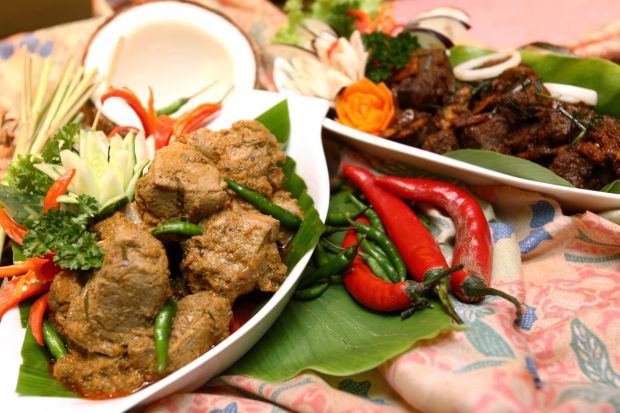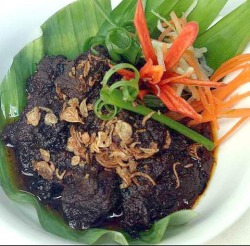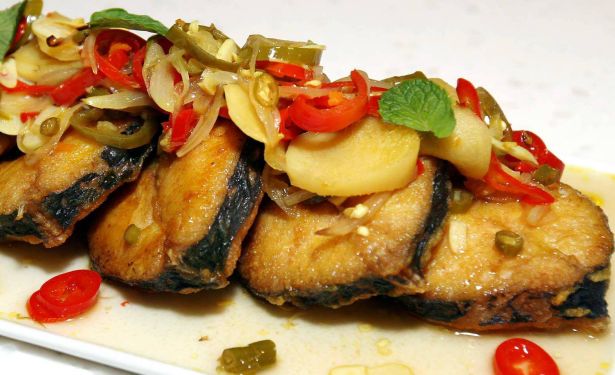Traditionally prepared for celebrations, rendang is now available everywhere and can be had anytime. Two chefs share their thoughts on the ubiquitous dish and name the different styles available in Malaysia.
WHEN the suggestion to write a story on various types of rendang was put forth, it was greeted with much enthusiasm. After all, rendang, like nasi lemak or roti canai, is a ubiquitous Malaysian staple that many would be loath to do without.
And what is not to like about the dish? Bites of tender beef, bursting with sweet and fragrant spices, coated with chewy shreds of grated coconut; surely, a killer combination that would bowl over the most seasoned foodie.
Apparently, that feeling is more mutual than earlier thought. CNNGo, a travel and city guide affiliated with US news channel CNN, recently published a list of the world’s 50 most delicious food. Rendang made it to the top quadrant at No.11. It was, however, attributed to our southern Asean neighbour, Indonesia.
Which brings us to the question of the origin of rendang. According to Hotel Equatorial KL Malay sous chef Azhar Alias, it can definitely be traced to the island of Sumatra, Indonesia.
“It is part of Padang cuisine, which was brought over by the Minangkabau ethnic group to Negri Sembilan,” he says. The Minang, as this group of people is known, moved to the west coast state as early as the 15th century.
Ashar Daud, executive sous chef of The 39 Restaurant at PNB Darby Park, KL, concurs: “A lot of Malay food has its roots in Indonesia or is largely influenced by the republic’s culinary traditions.”
From there, according to the two chefs, it spread to all the other states in Peninsular Malaysia, where it was further modified to suit local tastes and preferences. It is now, says Ashar, the pre-eminently authentic Malay dish that is very much attached to the culture.
 Chef Azhar Alias says that the best rendang is still found in the kampungs where it is cooked over a slow wood fire.
Chef Azhar Alias says that the best rendang is still found in the kampungs where it is cooked over a slow wood fire.“Similar to the indispensable role that mooncakes play in the Mid-Autumn Festival, rendang, to us, is an integral part of any celebratory activities,” he explains. The very creation of rendang, he adds, is based on gotong royong, which emphasises individual contributions for the common good.
“Whenever there’s a celebration such as Hari Raya or a wedding, the village folk will gather, bringing with them the ingredients that are most accessible.” For example, one family will turn up with clutches of lemon grass, another might bring galangal and someone else will bring dried chillies. Rendang is simply made with whatever is available at the village.
The making of rendang is also communal. “In comparison with, say, frying a fish which is done in no time, cooking rendang is a lengthy process that allows people to catch up,” reveals Ashar. Painting a picture of people gathered around a big wok of simmering rendang, stirring, laughing and sharing gossip, he says that this really brings people together.
Apart from the obvious reason of being able to cook a lot of rendang for many, the big wok is also used because it makes the best rendang. “Smaller ones do not work as well because the meat cooks too quickly,” he stresses. “It takes a much longer time for the spices to permeate and for the meat to become tender.”
While this method of preparing rendang is pretty similar from kampung to kampung, the taste, on the other hand, differs ever so slightly depending on which state you’re in. How discernible is this difference, though?
“Rendang is pretty much the same wherever you go; it is made with the same basic ingredients – kerisik (toasted grated coconut, which is a must), galangal, lemon grass, shallots, coconut milk, dried chilli and various spices such as cumin and coriander,” replies Equatorial’s Azhar.
“The difference lies in slight variations; more of this or that, and one or two additional ingredients,” he says. He uses the famous Rendang Tok from Perak to illustrate his point: “The dish – which is dark, almost black-ish in colour – is cooked with the addition of fresh coriander, black pepper, curry powder and brown sugar. Sliced coconut flesh is added to the concoction.”
 A Malaysian staple that goes well with rice, lemang or ketupat, rendang is a Malaysian favourite all-year round.
A Malaysian staple that goes well with rice, lemang or ketupat, rendang is a Malaysian favourite all-year round.According to him, the name Rendang Tok literally denotes “grandparents’ rendang” (“tok” is used interchangeably in Perak to refer to one’s grandfather or grandmother). This version of rendang is cooked over a slow fire for at least 2½ hours and attains a drier texture.
Meanwhile, Negri Sembilan’s rendang is more watery and spicier. “There’s more cili padi (bird’s eye chilli), lemon grass and galangal,” Azhar relates. Owing to the cili padi, the dish also takes on a slight green-ish tinge.
In Kedah, it is common to find rendang cooked with sliced beef instead of cubed chunks.
Kelantan’s, on the other hand, is slightly sweet. But this east coast state, says Azhar, is famous for something else – the dried beef jerky known as serunding. Serunding is, in fact, a variation of rendang as well.
“It’s just dried rendang!” chuckles Azhar, noting that a lot of the serunding sold in urban centres like Central Market in KL is mostly from Kelantan.
Ashar elaborates further: “Most villagers are loath to waste food, so what they do with rendang is they reheat it over and over again.” Kept in the chiller, it can last for about two months. However, it is most delicious if kept at room temperature so that it retains some of its moisture. “In that case, it’ll last for about two weeks,” he says.
 Chef Ashar Daud explains that a lot of Malay food has its roots in Indonesia, or is influenced by the republic’s culinary traditions.
Chef Ashar Daud explains that a lot of Malay food has its roots in Indonesia, or is influenced by the republic’s culinary traditions.Still, when Ashar was pressed for the characteristics of other styles of rendang, he was hesitant to give clear-cut details. He explains why: “Firstly, cooking is very subjective and when you’re dealing with such a traditional and home-based dish, it is not something that requires precision.” Because of that, he says, there are bound to be countless variations of the same recipe.
And in addition to the traditional recipes, there are also the newfangled ones. These days, everything can be made into rendang – chicken, venison and even seafood such as shrimp and cockles!
But nothing really compares to the original, muses Azhar. “Kampung rendang, cooked over a slow wood fire that gives it a smoky flavour, is still the best!” he exclaims.
Ashar, who maintains his purist stance, feels the same: “For some dishes, its main ingredient simply cannot be changed.”
For this reason, he feels that the meats (of local cows, buffalo and deer) that have been traditionally used to make rendang in Malaysia are still the better bet. “The longer it is braised, the better the rendang tastes.” This is why the tough local meats are well suited for the dish. The best, he says, is topside.
In contrast, tenderloin – already marbled and tender to begin with – will disintegrate when cooked for too long.
Azhar also gives some tips: The meat used to make rendang, he says, should be marinated the night before. If it is too firm, it can be boiled first before going into the wok with the rest of the ingredients.
Ultimately, though, cooking rendang is no simple task – it requires patience and skill. But the payoff from the effort, as many will attest, is worth it. As Azhar notes, it is popular, not only locally but internationally as well. “In most supermarkets around the world, it is possible to find pre-cooked rendang sauces in supermarkets.”
And with the availability of ingredients here in Malaysia, he muses that perhaps more of us should learn how to make this pillar of our cuisine in our kitchens.
Rendang Itik Kuala Pilah (Negri Sembilan)
Serves 10-15
Ingredients (A)
- ½ cup cooking oil
- 1½kg duck
- 3cm galangal
- 2pcs tamarind peel
- 4 cups coconut milk
- 4tbs kerisik
- Kaffir lime leaves and salt to taste
Ingredients (B) (to toast and grind)
- 10pcs dried chillies
- 1tsp coriander seeds
- 1tsp fennel seeds
- 1tsp black peppercorns
- Ingredients (C) (to grind)
- 5 shallots
- 3 garlic
- 3cm ginger
- 2 stalks lemon grass
- 3cm fresh turmeric
- 1½cm belacan Melaka (shrimp paste)
Method
Heat the oil in the wok, sautéall ingredients B until the aromarises.
Add the duck meat, ingredientsC, galangal, tamarind peel andkerisik. Cook until ingredients areintegrated and begins to boil.
Simmer the duck until itbecomes tender and the gravythickens.
Add kaffir lime leaves and salt totaste. Slow down the fire and cookuntil the gravy becomes thicker.
Ready to serve.
Rendang Tok (Perak)
Serves 15
Ingredients (A)
- 1½kg beef (cubed)
- 7 shallots
- 5 garlic (sliced)
- 2.5cm ginger (sliced)
- 2tbsp chilli powder
- 1tsp fennel seeds (ground)
- 1tsp black peppercorn (ground)
- 10pcs clove (ground)
- 1tsp turmeric powder
Ingredients (B) (to grind)
- 3 tbsp kerisik (or from ½ coconut)
- ½ young coconut (flesh only, sliced)
- 4 cups coconut milk (or from 5 coconuts)
- 2tbsp coriander seed powder
- 1tbsp fennel seed powder
- 10 cardamom seeds
- 5cm cinnamon
Method
Marinate meat with all the sliced and ground ingredients, kerisik,sliced young coconut flesh and coconut milk for two hours.
Cook the marinated meat in a pot and let it simmer atop slow fire for2-2½ hours. Remember to stir.
Add salt to taste. Cook until the rendang is dry and the colour changes to dark brown. Ready to serve.
Recipes courtesy of Chef Azhar Alias from Hotel Equatorial KL.







